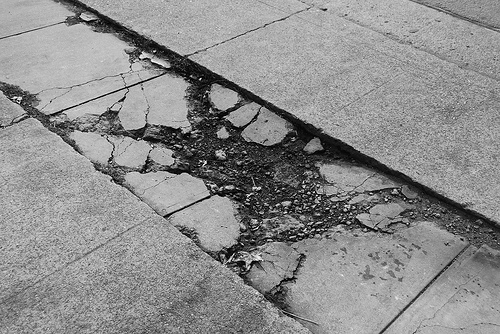Has Houston’s walkability been overstated?
Studies and activists claim that the most pedestrian-friendly town in Texas really isn’t.
Hot on the heels of Houston’s nomination as the most walkable city in Texas by WalkScore.com (a website that promotes “walkable neighborhoods”) comes a walkability analysis from AARP Texas that suggests that the city is anything but.

Houston was recently named Texas’s most walkable city. The AARP begs to differ. Via sdbrun; licensed under Creative Commons.
WalkScore.com gave Houston a 23rd place ranking throughout the nation, with other Texas cities earning spots at number 30 (Dallas), 31 (Austin) and 40 (San Antonio). WalkScore.com helps home-hunters find walk-friendly places to live, and awards scores to cities and neighborhoods based on the necessity of having a car measured against the ability of people to run errands on foot. Their ranking highlighted Neartown – Montrose, Midtown and Greenway/Upper Kirby Area as especially walk-worthy neighborhoods within the greater Houston area.
Yet AARP Texas, a nonprofit with the mission to “help to create a society where people 50+ age with dignity and purpose,” found in a separate investigation that Houston streets aren’t necessarily safe for pedestrians – especially those reliant upon walkers or wheelchairs. In fact, the AARP results were more in line with previous statistics from the U.S. Department of Transportation and National Highway Traffic Administration that painted Houston as one of the nation’s most dangerous cities for pedestrians. (Texas is one of the four leading states in pedestrian fatalities, according to their 2010 survey.)
As KUHF Houston Public Radio reported, the AARP conducted its own “walkability audit” to evaluate just how safe Houston streets are. Marla Turner of AARP and a group of reps from The Coalition for Barrier Free Living, in addition to bicyclists, walkers and other stakeholders such as a woman who has been confined to a wheelchair since infancy, inspected Houston streets.
The AARP team found cracked cement, poorly designed sidewalks, and warped areas of sidewalk that were unusable for those walking with the aid of a walker or using a wheelchair. They also noted that, at one particular intersection, the “walk” signal was not displayed long enough for their group to fully cross the street before the light changed. The results were particularly discouraging for walkers and bikers, as an estimated 40 percent of Houston residents do not drive.

For the able-bodied, challenges like a badly cracked sidewalk might be easy to navigate, but for people in wheelchairs or with mobility issues, they create much worse problems. The poor condition of Houston’s sidewalks are one thing critics target about its walkability. Via pfsullivan; licensed under Creative Commons.
Despite the unfortunate findings, there is forthcoming hope for improvement. The Houston Coalition for Complete Streets, an advocacy group which promotes “complete streets,” which are safe for those walking and biking as well as those driving or using public transit, is pressuring the state legislature to pass two relevant walkability bills.
The House Bill 1102 would consider the interests of all road users in a comprehensive “complete streets policy.” The Senate Bill 565 has a similar goal: to encourage “view[ing] all transportation improvements as opportunities to improve safety, access, air quality, and mobility for all travelers in Texas… and recognize[ing]that bicycle, pedestrian, and transit modes are integral elements of the transportation system.” The HCCS is also overseeing a complementary petition, Petition for Complete Streets for the Houston region, asking local government to “begin a transformation of how our infrastructure is built and maintained.”

Any environment shared by pedestrians and cars needs careful management. Pedestrian signs like these remind drivers that not everyone is wrapped in a few tons of steel.
Concerned pedestrians can learn more about the National Complete Streets Coalition here, run by Smart Growth America, a group of organizations concerned with the environmental, economic and local impact of urban expansion.
Category: Pedestrian safety, Road safety



















Comments (2)
Sites That Link to this Post